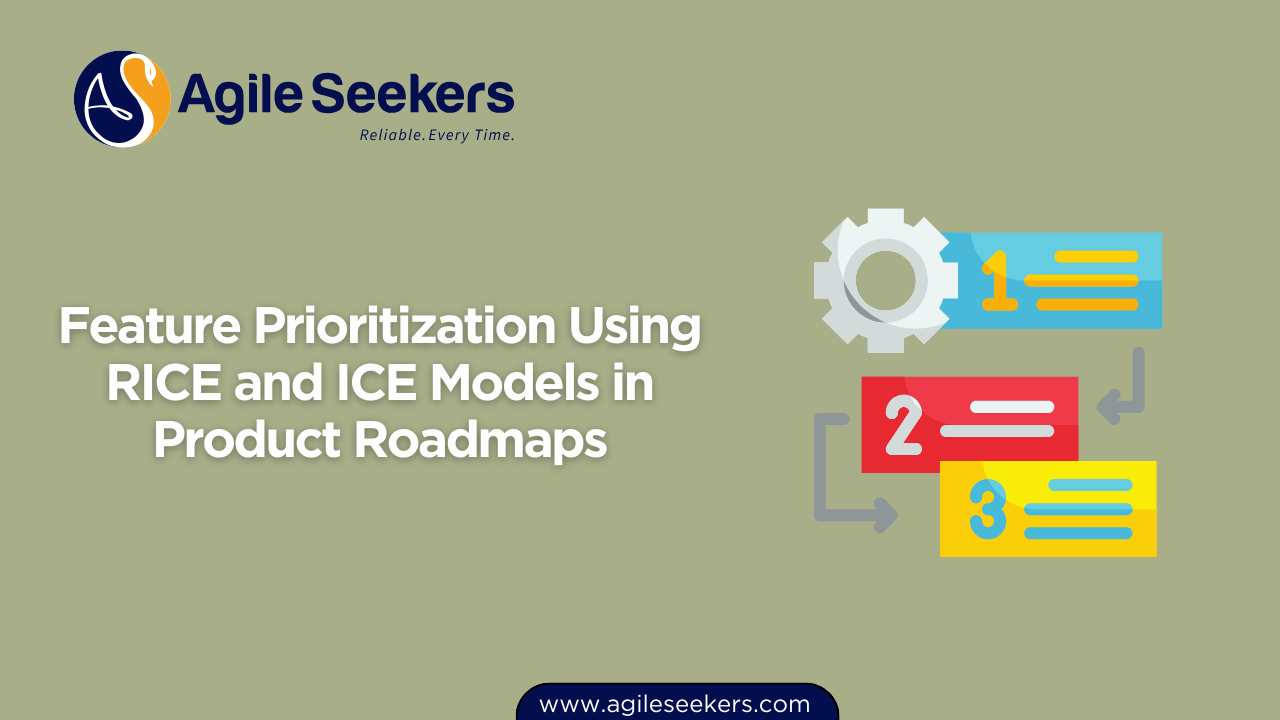Feature Prioritization Using RICE and ICE Models in Product Roadmaps

Product teams often face a tough question: what to build next? With limited time and resources, selecting the right features to prioritize in your roadmap can make or break your product’s success. That’s where frameworks like RICE and ICE come in. These models help product managers apply consistent, data-driven thinking to backlog prioritization, reducing bias and surfacing the highest-impact initiatives.
Why Prioritization Frameworks Matter
Without a clear method, feature prioritization can turn into a subjective debate influenced by the loudest voice in the room. A structured approach ensures that every idea is evaluated against defined criteria and aligned with business goals. This becomes especially important for those managing scaled Agile programs or large product portfolios, where frameworks like SAFe and SAFe POPM Certification are in use to drive consistent delivery.
What Is the RICE Framework?
RICE is a scoring model that helps prioritize features based on four key factors: Reach, Impact, Confidence, and Effort. Each component plays a role in determining the potential return on investment.
| Factor | Definition | How It’s Measured |
|---|---|---|
| Reach | How many users will this impact within a given time period? | Users per month/quarter |
| Impact | What is the expected outcome for each user impacted? | Scale: 3 = massive, 2 = high, 1 = medium, 0.5 = low |
| Confidence | How sure are you about your reach and impact estimates? | Percentage (e.g., 80%) |
| Effort | How many person-months will it take to build and deliver? | Estimated developer effort in time |
The RICE score is calculated with this formula:
RICE Score = (Reach × Impact × Confidence) / EffortUse this formula to rank initiatives. Higher scores indicate features that are expected to deliver more value for less investment.
Example of RICE in Action
Let’s say you have two ideas: Feature A targets 1,000 users/month, has high impact (2), 90% confidence, and would take 2 person-months. Feature B impacts 300 users/month, with medium impact (1), 80% confidence, and 1 month of effort.
- Feature A RICE Score: (1000 × 2 × 0.9) / 2 = 900
- Feature B RICE Score: (300 × 1 × 0.8) / 1 = 240
Feature A clearly offers more value per unit of effort and should be prioritized.
What Is the ICE Framework?
ICE is a simpler model compared to RICE. It focuses on three factors: Impact, Confidence, and Ease. It works well in early-stage planning or when you have limited data.
| Factor | Description |
|---|---|
| Impact | How much will this feature move the needle? |
| Confidence | How sure are you about your assumptions? |
| Ease | How easy is this feature to implement? |
The formula is straightforward:
ICE Score = Impact × Confidence × EaseEach factor is scored on a scale of 1 to 10. For instance, a quick fix with a moderate impact and high confidence might score higher than a complex project with unclear benefits.
When to Use ICE vs. RICE
Use ICE for rapid prioritization when you lack detailed user metrics or effort estimates. It’s lightweight and works well in brainstorming sessions. RICE, however, is more rigorous and suited for larger teams where decisions need clearer justification and alignment with product strategy.
Using These Models in Agile Roadmaps
Both RICE and ICE can integrate into Agile product development cycles. When managing feature flow within a SAFe Product Owner/Manager certification environment, these models help streamline backlog grooming, planning, and roadmap communication.
Product Managers trained in frameworks like SAFe or PMI’s Project Management Professional certification often apply these models during quarterly PI planning or release planning meetings. It supports objective feature scoring and prioritization aligned with value streams.
Tips for Implementation
- Align with stakeholders: Share RICE or ICE scores during roadmap reviews to back decisions with logic.
- Be realistic: Confidence scores should reflect how much data or research backs your estimates.
- Review periodically: Priorities change. Refresh your scores as new data comes in or goals evolve.
- Visualize scores: Tools like Productboard, Aha!, or even Google Sheets make it easy to compare features and decide what to build next.
Common Pitfalls to Avoid
While useful, these models are not perfect. Avoid these mistakes:
- Overestimating impact: Validate assumptions with real user data or feedback.
- Ignoring effort estimates: Underestimating effort skews the RICE model, especially for engineering-heavy features.
- Using static scores: Product needs change. Prioritization is not one-and-done.
For teams looking to build strong foundational knowledge in structured delivery, certifications such as PMP training can enhance planning and execution capabilities in feature delivery. Similarly, SAFe POPM training equips product professionals with tools to lead prioritization at scale.
Final Thoughts
Prioritization is both art and science. The RICE and ICE models give teams a repeatable, data-informed way to select the right features at the right time. When backed by stakeholder alignment and ongoing iteration, these frameworks lead to faster value delivery and fewer wasted development cycles.
For product managers looking to sharpen their planning skills and influence better decision-making, structured frameworks like RICE and ICE are essential tools in your toolbox. Pairing these techniques with professional training—whether it’s SAFe Product Owner Certification or PMP certification training—can strengthen your ability to lead with confidence and clarity.
For more depth, consider exploring this Intercom guide on RICE prioritization or this Product Coalition article on ICE scoring.
Also read - Creating and Managing Technical Product Requirement Documents
Also see - Understanding API Design Principles for Product Managers




















